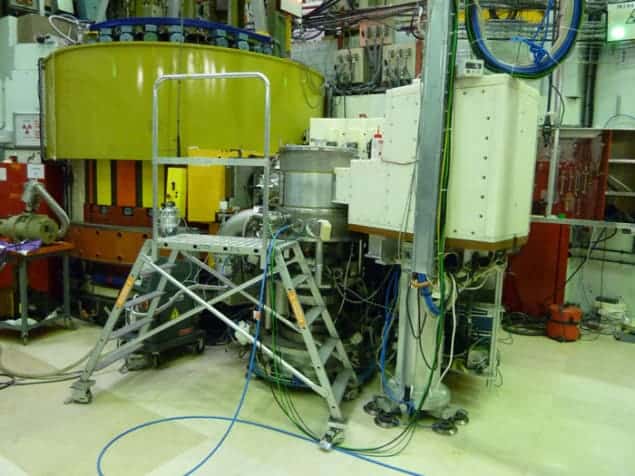
Neutron-scattering measurements using different isotopes of oxygen have been made for the first time by an international team of researchers. The scientists have used the new technique to determine important differences between the molecular structures of normal and heavy water, saying that it could be used to study a wide range of oxide materials including some glasses.
Neutron scattering involves firing a beam of neutrons at a sample and studying the resulting diffraction pattern that occurs when the wavelength of the neutrons is about the same size as the distance between nuclei in the sample. While normally associated with the study of crystalline materials, the technique can be useful for studying disordered materials such as liquids.
Scientists cannot normally extract much information from a disordered sample because it is impossible to differentiate between scattering from different pairs of atomic nuclei. However, much more information can be obtained by repeating the scattering experiment with a sample in which atoms of one type (typically hydrogen) are replaced by a suitable isotope of the same atom (typically deuterium). This alters the diffraction pattern because neutrons scatter differently from different isotopes of the same nucleus. Subtracting one pattern from the other therefore leaves the contribution to the pattern from the substituted nuclei alone.
The same, but different
Substituting hydrogen with deuterium has become a successful technique because the scattering between these two isotopes is so markedly different. However, there are two drawbacks. First, the technique is based on the assumption that hydrogen and deuterium are chemically identical, which is only true up to a point. Deuterium is twice the mass of hydrogen, which means that the two isotopes do not always behave the same way within molecules. The second problem is that physicists have long assumed that for some other important atoms of interest – particularly carbon and oxygen – the scattering contrast between the isotopes would be too small to give a useful signal.
Now, Philip Salmon and Anita Zeidler of the University of Bath, Henry Fischer at the Institut Laue-Langevin (ILL), and their colleagues at the Oak Ridge National Laboratory, Stanford University and the Vienna University of Technology, have demonstrated a new isotope-substitution technique that solves both problems. Their breakthrough draws on a technique developed in 2008 by several members of the team, who had hoped to exploit the difference in scattering between two isotopes of carbon. Although that difference proved to be smaller than previously thought, the researchers then turned their attention to oxygen-18 and oxygen-16. This time they found a much larger difference than expected – so much so that the researchers went ahead with an oxygen-isotope substitution measurement of water using the D4C instrument at the ILL neutron source.
In their experiment, Salmon and colleagues made one neutron-diffraction measurement on a water sample comprising oxygen-16 and hydrogen, and a second on a sample comprising oxygen-18 and hydrogen. Subtracting one diffraction pattern from the other gives the separation between the oxygen and hydrogen nuclei in water – the oxygen–hydrogen bond length. The measurements were then repeated using deuterium instead of hydrogen. Using these data, the team was able study important differences between normal and heavy water for the first time.
Competing effects
In particular, the researchers found that there is a 0.5% difference between the lengths of the oxygen–hydrogen and oxygen–deuterium bonds. This finding supports a “competing quantum effects” model that describes the structure and dynamics of liquid water. This information can now be used to create more realistic computer simulations of liquid water – a substance that has proven very difficult to simulate effectively.
Alan Soper of the ISIS neutron lab in the UK says that the researchers’ apparent confirmation of the viability of the oxygen-isotope method is “a major breakthrough”. However, he points out that even with the revised difference in scattering between the two oxygen isotopes, an extremely stable instrument is required. “Currently, D4C at ILL is ahead of the game in terms of stability,” Soper told physicsworld.com. He also warns that the next generation of neutron sources will be spallation sources – based on accelerators rather than reactors like that of the ILL – and may therefore not be stable enough for these kinds of measurements.
Salmon is more confident, and points out that tests on the NOMAD instrument – currently being built for the SNS spallation source at Oak Ridge by team member Jörg Neuefeind – suggest that it will offer comparable stability to D4C.
As well as studying water, Salmon and colleagues believe that oxygen isotope-substitution could be applied to other materials with oxygen contents that are greater than about 33%. It could, in principle, be applied to glassy solids – materials that have so far proved very difficult to model. However, Soper points out that such analysis would have to work around the possibility that small, random structural differences between different glass samples could overwhelm any differences arising from isotope substitution. Salmon, on the other hand, believes that the potential rewards associated with applying the technique to oxide glasses “will more than offset any remaining technical issues”.
The work is reported in Physical Review Letters.



